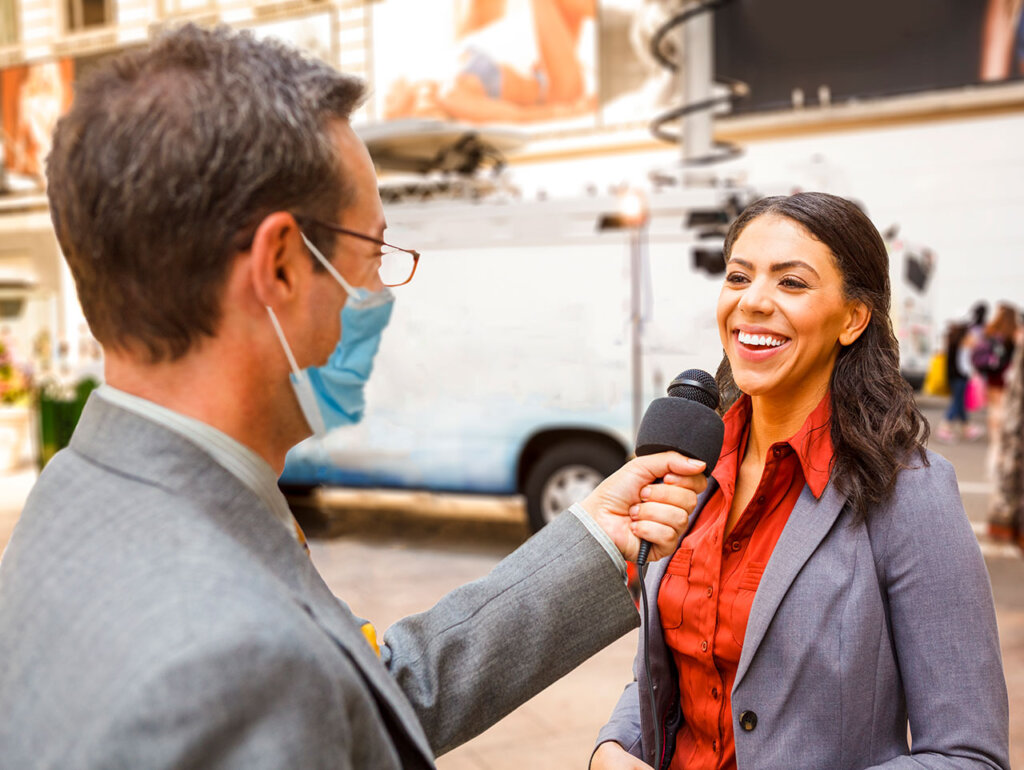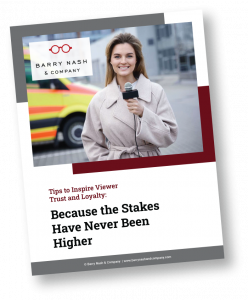Standing to deliver a story should increase your power as a communicator and as an anchor. In “real life,” we stand to demand attention when we have something of added importance to say, when we are in an elevated role (like the featured speaker at an important event), or when something deserves special acknowledgement (a standing ovation).

So why does standing to deliver the news so often have the opposite effect? Too often, when anchors come out from behind the desk they look like they’re doing it simply because someone has told them to. There’s no feeling of purpose or motivation. They look stiff and uncomfortable, often to the point that it diminishes their authority and distracts from the story they’re telling. “When he stands I can see all of him, but he’s half the man he is when he is sitting,” is a quote that would apply.
A STAND UP ANCHOR
From a performance standpoint, the antidote to this is both mental and physical. Click here to view a series of newscast clips featuring Memphis anchor, Greg Coy. They are a great study if you’re looking to make the most of your time on your feet.
THE PHYSICAL WORK
He is relaxed below the waist. The single most important thing most anchors can do to be more effective when standing is simply to relax enough to shift their weight and move their feet while they talk. When the knee are locked and the feet are frozen in one spot, that stiffness usually finds its way into the rest of the body, and into the voice as well.
He keeps moving and gesturing. Research has shown that almost everything works better when you gesture. Your face is more expressive. Your speech is more conversational, and even your brain works better (Your memory is better and you use language more creatively.) In other words, you look and sound and even think better when you are moving, and this seems especially important when you are standing and out from behind the anchor desk.
The script in his hand does not impede his movement. He refers to it naturally when he needs to, and he does not grip and park it in front of him like a shield.
He keeps his body working toward his point of focus. When he addresses the camera, for instance, he leans slightly toward it. The effect is that he seems genuinely interested in gaining the viewer’s attention.
He moves his attention easily and aggressively from the camera to the monitor on the set. When he turns to address the monitor, he does it without hesitation or compromise. We often see anchors turn tentatively and incompletely when they have to direct their attention to something on set other than the camera. Instead of “owning” the space, they are owned by it. Instead of working with more authority, they have less.
He manages his volume well. It is higher at the top of the show, when he needs to meet the energy of the open and related production. Then, as he works into the show he shifts to a level that is more conversational and accessible.
THE MENTAL WORK
What you can’t see, of course, is how the anchor is thinking about what he is doing, and he you stand the mental work you do is just as important as the physical work. In our experience, these mental adjustments can be especially helpful when you are on your feet:
Relate the business of standing to the story(ies) you’re telling. In your mind, you should be on your feet because the story deserves it for some reason, not just because a producer has assigned you a different location on the set.
Think of the space as your own. The more at home you are there — the more aggressively and easily you move in the space — the more comfortable viewers will be watching you.
“Wear” your body proudly, however it’s shaped. Discomfort with the way you look can make you tentative or cause you to “pose” in whatever position you consider the most flattering. To be your best, you need to be able to put those concerns aside, focus on the stories instead of yourself, and “bring it” passionately and unapologetically. One last, important thought: In the clips above, Coy seems to relish his role and likes what he is doing. There are few things as compelling as watching someone who really loves what they are doing and is not afraid to let it show, and television news is no exception to that. He looks very much at home — and very happy to be there.










